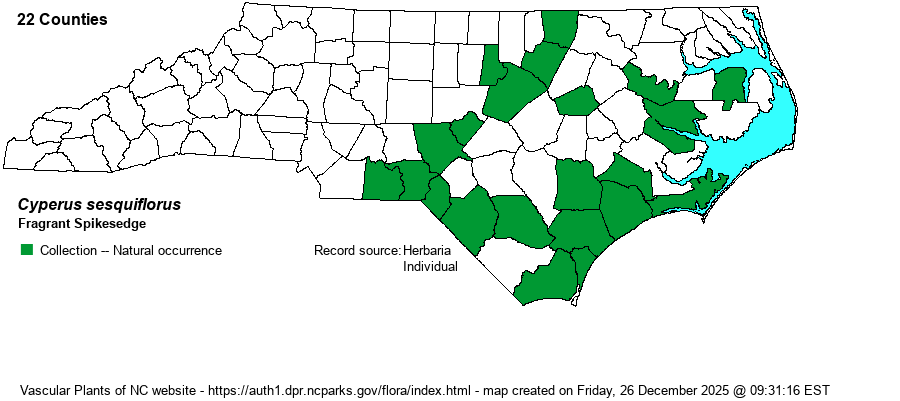| Author | (Torrey) Mattfield & Kuekenthal | |
| Distribution | Coastal Plain, Sandhills, and lower Piedmont.
Pantropical, north to NC and AR. Though it ranges north to the VA border, the species is not yet known from that state. | |
| Abundance | Uncommon to frequent in the Coastal Plain; rare in the Piedmont. | |
| Habitat | Moist to wet margins of ponds and impoundments, blackwater rivers and streams, seepage areas, clearings, roadside ditches. Usually in sunny and damp places. | |
| Phenology | Flowering and fruiting July-September. | |
| Identification | Fragrant Spikesedge is an attractive little plant. It grows 5 inches to one foot tall, multi-stemmed, with a single densely flowered head at the stem summits. The heads usually have 1-2 basal lobes. Female scales, and thus the head color, are white or whitish gray (vs. green in C. hortensis). | |
| Taxonomic Comments | A synonym is Kyllinga odorata.
The genus Cyperus is mostly tropical and warm-temperate in distribution; thus, in NC it is much commoner in the Coastal Plain than in the Mountains and Piedmont. Most species have 1-few flowering stems (culms) from grasslike basal leaves, plus a few stem leaves. At the summit is an inflorescence of very open and branched, or tightly packed, spikes, varying among species from brown to golden brown to straw-color to reddish. The arrangement of the spikelets is important, whether like a hand (digitate) or in paired or alternate rows (pinnate); as is the shape of the achene (seed), whether bi-convex in cross-section or triangular. As a group, Cyperus tends to be weedy and readily enters disturbed ground; this is true for many natives as well as all the aliens. In recent years, following DNA research, the genus has incorporated several genera that in RAB (1968) or other manuals were separate: Hemicarpha, Lipocarpha, and Kyllinga. | |
| Other Common Name(s) | Whitehead Sedge | |
| State Rank | S3 | |
| Global Rank | G5 | |
| State Status | | |
| US Status | | |
| USACE-agcp | | |
| USACE-emp | | |

